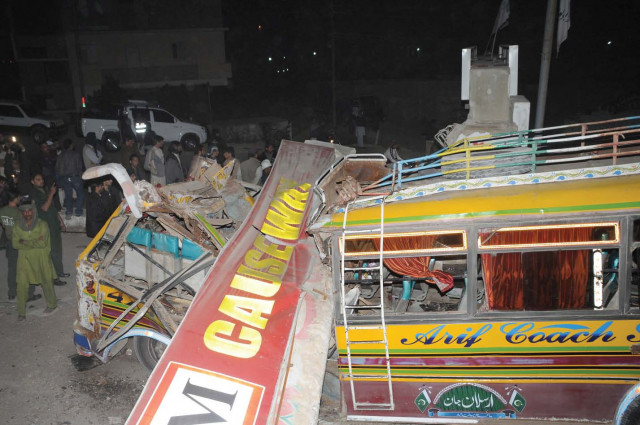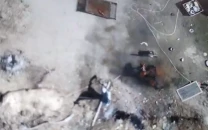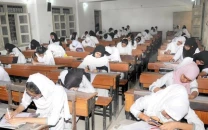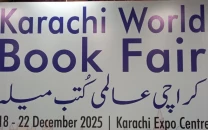Of weddings and funerals: The family and bus driver blame each other for Korangi accident
Shop owners say that accidents are likely since the high trap is not entirely visible .

As they looked at what remained, they also made their own conjectures about what could have happened.
The bus, with 70 passengers on their way to a wedding, had rammed into an overhead concrete barrier at the EBM Causeway in Korangi Industrial Area. It was put up to stop heavy traffic from coming onto the road. The barrier fell onto the bus and ripped it apart.
Seven people died. Six were from the same family while the seventh was a little boy.
“I don’t understand how a concrete block so large can fall on a bus so easily,” said a man who had stopped to look at the wreck. “What is the use of wondering about that?” mused the woman who was with him. “Think of the family,” she said. “They must be going through hell right now.” But Saifur Rehman, a resident of nearby Gulzar Colony, kept shaking his head.
“No, no... This was bound to happen,” he said aloud. “The high trap was not placed properly over the pillars. Come and look at it.” He took people’s hands and led them to the pillars for a closer observation.
According to Rehman, the high trap on the opposite track did not seem to be cemented into place.
“It was picked up and just placed over the pillars,” he said. “So it collapsed when the carrier of the bus rammed into it.”
He said that there were no speed ramps or a sign board to warn the drivers and told about one of his neighbours, who was seriously injured because of the overheard barrier. “He was sitting on top of a truck which tried to pass through the barrier just like the bus.”
People running businesses along the road had similar stories to share. Kashif Shah, who has a paan kiosk nearby, said that accidents were common, especially at night. “It’s pitch black here during the night,” he said. “The three street lights you see right over the high trap are switched off most of the time.”
Only a month back, a Suzuki pickup carrying oxygen cylinders also bumped into the high trap, said Shah. “The drivers normally don’t have any idea about its height. They trust their instinct and then ram into it.”
While the police post at the Brooks Chowrangi refused to verify it, the people of the area said that three men had also died two months ago. A Mazda truck tried to speed through the overheard barrier.
The causeway
There is a plaque at the site, according to which the causeway was inaugurated by Sindh Governor Dr Ishratul Ibad on February 12, 2011. The causeway is mostly used by the residents of Korangi and Landhi to go to Shahrah-e-Faisal and avoid traffic jams at Qayyumabad Chowrangi. The barriers help to stop trucks carrying goods from Korangi Industrial Area.
What do the authorities say?
Karachi Metropolitan Corporation (KMC) officials were quick to pass the buck. “We have nothing to do with the causeway. It was built by EBM (English Biscuit Manufacturers),” said the spokesman Ali Hasan Sajid.
On the other hand, the director general technical service at Karachi Municipal Corporation (KMC), Altaf Memon, had concerns over the visibility of the road. “We haven’t been able to put up enough street lights because there is no system of constant power supply,” he said. “The high tension wires cross right above the road and we still have to make arrangements to give power to the street lights,” he said.
When asked why no measures had been taken so far, Memon said that the road was built by the College of Business Management. “The bus driver was also not from Korangi,” he said. “Otherwise he must have known that the causeway was not open for heavy traffic.”
But KMC’s road safety consultant, Sattar Javed, minced no words in blaming the civil engineers who design the roads. “Safety features are often ignored,” he said. “It is very important to enhance visibility when a barrier like this is put in place.”
The funeral
The funeral prayers of Aslam, 65, his wife Shamim, 55, daughter Shazia, 36, two granddaughters Minahil, six, and Fatima, four, sister-in-law Naseem, 42, and a neighbouring boy Muzammil, who was nine years old. They were laid to rest in Konragi No.1 graveyard. The funeral was attended by many, including, the residents, relatives and friends of the victims.
The survivors
The passengers stuck inside the bus were rescued by cutting through the wreckage. According to the family, they were on their way to Gulberg from Korangi to attend the combined valima ceremony of Aslam’s two daughters when the accident took place.
“It was the valima of my two sisters-in-law,” said Amir Hussain, whose wife, Shazia, and daughter, Manahil, died in the accident. Hussain, who works at a private company, alleged that it was the driver’s negligence that caused the accident. According to him, it was also the driver’s suggestion to go via the causeway.
“He is a professional driver. He should know how the routes are,” said Imran, another family member who was also injured. “Everyone was busy having fun. We were stuck there for half an hour after which the crane came and the people buried beneath the beam were rescued.”
Two persons are still admitted in Jinnah hospital. The doctors said that they were in a critical condition and were being kept in the ICU.
The investigation
The police detained the bus driver, Sajid, 25. According to him, he had no idea that there was an overhead barrier on the road. But, he said that he did as he told, unlike the family’s claims.
“There were over 70 people stuffed in the bus,” he said. “If all turned out well then it would have been God’s doing. When I asked where to go from, a voice called out from the back of the bus asking me to take the EBM causeway. Now that their family members have died, I am the bad guy.”
However, the police are still waiting for the police to register a case. SHO Malik Ayub said that the people onboard were responsible for the accident themselves. “They are residents of Korangi,” he said. “They should know that a bus can’t go onto the causeway. None of them even thought about it.”
He said that he did not think that a case should be registered against the driver or the authorities. It was common knowledge that the road was closed for heavy traffic. The colourful boards on the overhead beams at the road’s entrance are also reflective, he added.
Published in The Express Tribune, February 20th, 2012.



















COMMENTS
Comments are moderated and generally will be posted if they are on-topic and not abusive.
For more information, please see our Comments FAQ